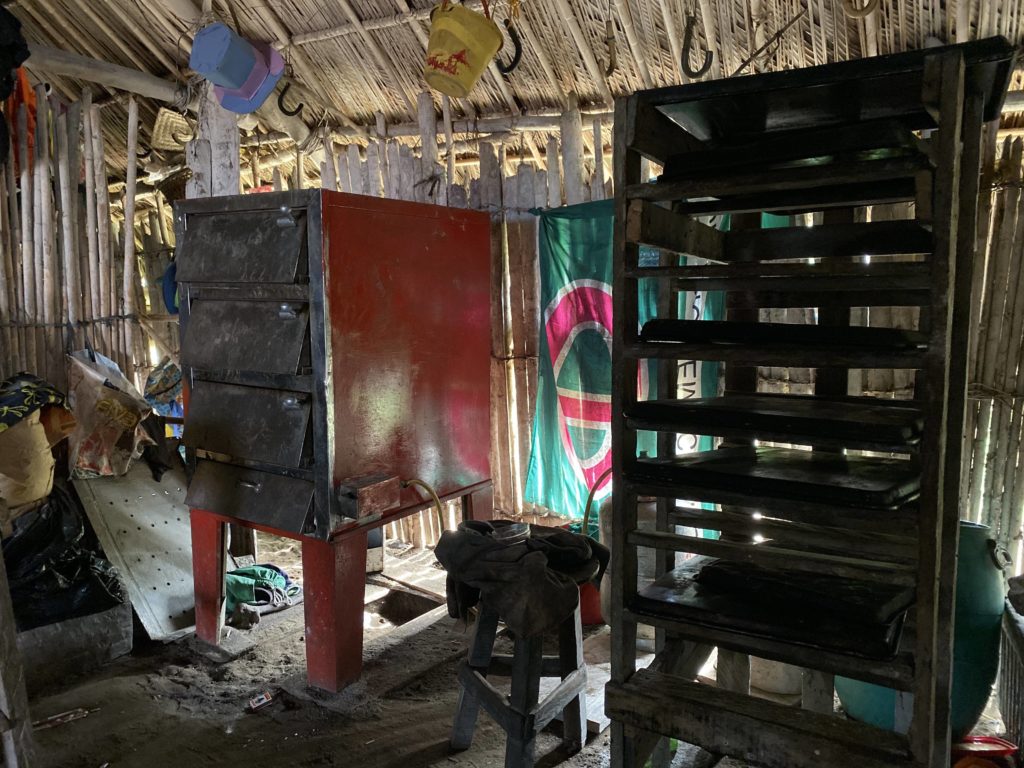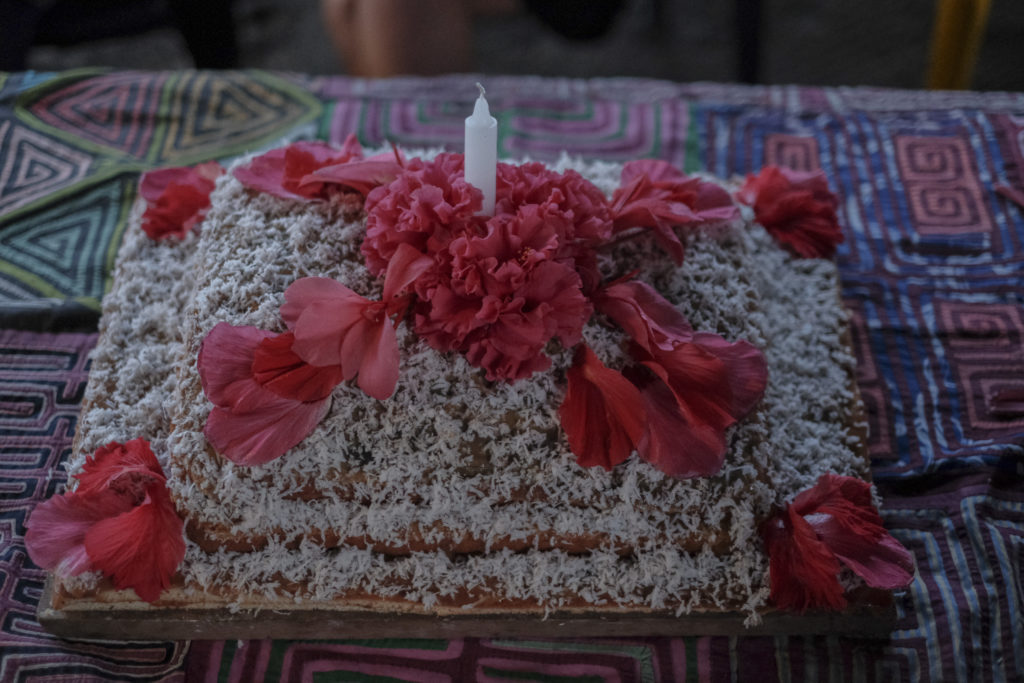I wake up almost too late to join Nacho and the rest to collect coconuts. I race out of bed and there they are on the opposite shore, just setting off. I shout, “Hola!” And Nacho graciously paddles back to get me. We walk along a well-trodden path, past a series of fincas that belong to Nacho, his cousin and his wife. Each farm is a hectare or two and is full of coconuts, plantains, bananas, and papayas. The coconuts are sacred and if someone picks another man’s coconut, there is a $5 fine. So the coconuts lie where they fall, secure.
The green ones are called pipa and they are still tender and full of juice. But Nacho is after the brown ones. A group of locals meet us at his finca. We thought we were going to help split the coconuts, but it isn’t that easy. The men do it with a long tool that looks like a kind of plier, efficiently splitting the husk so that the younger kids can pull out the seed.
The seed is used for various things in the community while the husk is left behind. Sometimes people will come along and use it to make a fire as it burns really well. We walk back along the beach. It is a 6km stretch of beautiful sand.

Trash is there, but it sits higher up. This would be a real estate developer’s wet dream and it is all the more beautiful for it being untouched by the grasping hands of the modern world. Halfway down the beach, Nacho leads us back to another of his fincas. He uses a long bamboo pole, sharpened at one end, to nick coconuts from the tree.
I try my hand and manage to dislodge one. It isn’t easy! He expertly slices chunks of them off and gives each of us a coconut to drink from. It is thirst quenching and absolutely perfect. He then splits the coconut like a samurai, a single stroke down the middle, strong and sure. I don’t volunteer to try the machete. I want all my fingers intact! The coconut flesh is tender, juicy and very tasty. Quite possibly the best coconut I’ve had in my life.

Walking back to the village, a light rain begins to fall, cooling us off as we go by a bevy of plants that have a range of properties and uses. The biodiversity is incredible. Here’s a plant whose fruit is used to make jam. Here is a flower none of us have ever seen before.
I am suddenly reminded of numerous long, solo walks I’ve taken in my years of travel all over the world. I’ve always thought that I work best alone, that solitude is the succour for my creativity, that it is about nourishing my well by drinking alone so that I will be able to produce. But perhaps that is just one way of looking at life. Over here, we are a group of artists within a larger community. One that does everything together. I ask Nacho why people don’t build houses on this side of the river. The view is incredible and there’s so much space. He replies that the Guna prefer to be together. They are not a solitary people.
In community, they remember their stories. In community, they reinforce a way of life. In community, they draw the most out of life.
At the house, Luz is preparing the batter for a giant birthday cake. Nacho’s family is throwing a party for his granddaughter, Nague. It’s her 15th birthday. And there will be plenty of beer and rum and food this evening. Once the batter is ready, Luz pours is into large trays and we carry it to one of the ovens in the village.

This particular one belongs to Hernanto, who is one of the sahilas. He wakes at 4 am every day to bake bread, which usually sells out by 7am. The Guna are a terribly hard working people. Most of them wake around 5am to get a whole range of chores done before the sun rises. They don’t sleep that early either! Music plays on well past 11pm and a television is always showing something somewhere. Not every house has a TV, though, so television does become another reason to gather.
At breakfast, we remark on Nacho being almost god-like in his ability to do so many things at once. He pays attention to one thing at a time, but his peripheral awareness is very balanced. So he is always thinking about what is happening in the house, and is always ready to jump in and out of conversation. A parallel thought to this is Maria’s comment that we don’t think through or with language, rather, through a series of sensations; of desire and non-verbal affects which our brain then translates into words and then sentences (perhaps). We then attach context and emotion as an afterthought, dismissing what we first felt as something primal, when it really is the thing we have to be most aware of.
Nacho beckons us over to see two roosters that he has killed to make chicken soup for the party tonight. He dips them in hot water so soften the skin and then starts to defeather them, expertly plucking out the short and long feathers. The chickens in his coop are all natural. No pesticides, no injections. He could sell one for $15USD. Not all the chickens we eat are from his garden, and he says the taste is very different. I think the chicken we consume is bought from Francisco’s store. I’ve seen pieces of raw chicken floating in a pail beside the beer coolers.
Over lunch, Luz tells us a little about house building for the local community. The entire village pitches in to build a traditional house from sticks and thatch. Everyone gathers materials for two weeks and then everyone builds a house in a single day.
There are members from the General Congress visiting Nacho today. As an important man in the village, Nacho is not only innovative but is also deeply connected to the community. He doesn’t think about making a profit off his skills and advantageous position but always has the good of the community at heart. He could have housed us in cabins that he owns at the edge of the village but instead, he got the community to convert an old Congress house by the river to become the main residency space for the artists.
Nague’s party takes hours to prepare for. Aida has been cooking all day. She expects 50 people to come. Nague’s entire class will be there. Luz’s cake is huge; it is a three-tiered con de leche. Maria and her grate coconut over it and place flowers from Nacho’s garden on top. It looks like a wedding cake.
A gaggle of 15 year olds occupy all the chairs. They are ravenous and the food doesn’t really come out until 8pm, so they busy themselves on their phones, watching music videos. We wonder where and how they get their content and also think about the effect these videos could have in how they see the world. Do they feel stifled here? Or are they able to live with the knowledge that there is an entire world out there that isn’t for them? Many adults in their 20s and 30s have left Armila to work in the city. And some, like Nacho, return to make a life back in the village later on. We often talk about going back to the real world after a holiday. After being here for a week and a half, I’m really not sure what the real world means anymore.
The older people at the party are Nague’s teachers and a handful of sahilas. A few beers in, everyone is starting to slur and Nacho tries to impress me with his drunk English. He makes no sense! One of the sahilas is pretty tipsy, but still lucid enough to hit on Maria, spinning a line about how Lord Of The Rings is from Iceland and how beautiful she is and how he would like a beautiful lady to pay for him to visit Iceland and would she like to take him there? He definitely crossed a line there. But what can you do? We laugh about it later and try to think of ways to exit such uncomfortable situations. The best line we come up with is ‘Estoy teniendo diarrea’, ‘I am having diarrhoea.’





